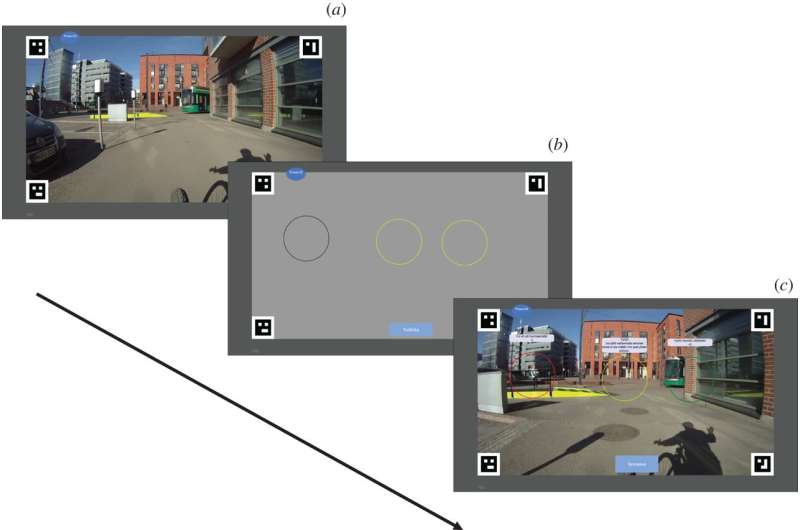March 22, 2017 report
Video-based learning game may help make cycling safer for kids

(Medical Xpress)—A team of researchers with the University of Helsinki has developed a video-based learning game that might make bike riding safer for everyone, but particularly so for children. In their paper published in the journal Royal Society Open Science, the researchers describe the type of riding skill they are attempting to improve and why they believe their game may help.
One of the biggest obstacles to safe driving, the researchers note, is maintaining situational awareness—the ability to keep track of other objects and things that are moving so as to continually asses the likelihood of something causing a problem. An example of this would be noting a car traveling along an upcoming road prior to encountering an intersection, while also keeping in mind where that dog was you saw a moment ago and a bus that has stopped behind you.
People become more situationally aware as they grow older, particularly when they learn to drive a car. But, the researchers note, situational awareness is a learned ability, and thus it is not very strong in children who venture out on a bicycle. That is where the game they created comes in—it allows children and adults to strengthen their situational awareness in the safe confines of their home.
The game offers the real-world perspective of a person traveling on a bicycle. As the person pedals, they are free to look around, hopefully to notice potentially dangerous situations. Then the screen suddenly goes blank except for three colored circles. The circles are situated over what the game makers have designated as something riders should have noticed. The player is then given the chance to identify those hazards without actually seeing them. Once they make their choices, the simulated real-world situation returns to the screen with the circles still in place, allowing the player to see the hazard and for the game to give a score regarding how accurate the player was when making their choices.
As a player continues to play the game, other obstacles and hazards are displayed and the rider leans to look for them so they can better their score. Doing so, the researchers are hoping, will translate to better real-life situational awareness and safer bike riding.
To test the game, the researchers received permission to allow 36 nine- to 10-year-old students from a local school to play the game in addition to 22 adults that volunteered. They found that adults did better, but that both groups improved over time. Of course, the only way to find out if the game actually makes bikers safer is to get a lot of people to use it, and then look to see if the accident rate goes down—a trial that could take a while—but the researchers are optimistic. They believe if they make the game available on the internet and offer it free to everybody, it could reduce accidents, particularly among children.
More information: Esko Lehtonen et al. Game-based situation awareness training for child and adult cyclists, Royal Society Open Science (2017). DOI: 10.1098/rsos.160823
Abstract
Safe cycling requires situation awareness (SA), which is the basis for recognizing and anticipating hazards. Children have poorer SA than adults, which may put them at risk. This study investigates whether cyclists' SA can be trained with a video-based learning game. The effect of executive working memory on SA was also studied. Thirty-six children (9–10 years) and 22 adults (21–48 years) played the game. The game had 30 video clips filmed from a cyclist's perspective. Each clip was suddenly masked and two or three locations were presented. The player's task was to choose locations with a potential hazard and feedback was given for their answers. Working memory capacity (WMC) was tested with a counting span task. Children's and adults' performance improved while playing the game, which suggests that playing the game trains SA. Adults performed better than children, and they also glanced at hazards more while the video was playing. Children expectedly had a lower WMC than adults, but WMC did not predict performance within the groups. This indicates that SA does not depend on WMC when passively viewing videos.
© 2017 Medical Xpress



















